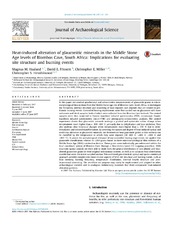Heat-induced alteration of glauconitic minerals in the Middle Stone Age levels of Blombos Cave, South Africa: Implications for evaluating site structure and burning events
Peer reviewed, Journal article
Published version

Åpne
Permanent lenke
https://hdl.handle.net/1956/16911Utgivelsesdato
2017-10Metadata
Vis full innførselOriginalversjon
https://doi.org/10.1016/j.jas.2017.06.008Sammendrag
In this paper we conduct geochemical and colourimetric measurements of glauconite grains in micromorphological thin sections from the Middle Stone Age site of Blombos Cave, South Africa, to investigate the formation, internal structure and reworking of heat-exposed cave deposits that are related to prehistoric burning events. Controlled heating experiments were first carried out on glauconite-rich loose sediments and block samples, both of which were collected from the Blombos Cave bedrock. The control samples were then subjected to Fourier transform infrared spectrometry (FTIR), microscopic Fourier transform infrared spectrometry (micro-FTIR) and petrographic-colourimetric analyses. The control experiment shows that glauconitic minerals undergo a gradual and systematic colour change when temperatures reach higher than c. 300–400 °C, primarily due to dehydration and iron oxidation. They also undergo clear structural changes when temperatures reach higher than c. 550 °C due to dehydroxylation and mineral transformation. By assessing the nature and degree of heat-induced optical and molecular alteration in glauconitic minerals, we demonstrate how glauconite grains in thin sections can be classified by the temperature to which they were exposed (20–400 °C, >400 °C, >600 °C and >800 °C). To assess the archaeological relevance of our controlled heating experiment, we applied this glauconite classification scheme to >200 grains found in three micromorphological thin sections of a Middle Stone Age (MSA) combustion feature. These grains were individually geo-referenced within the local coordinate system of Blombos Cave, through a thin-section-based GIS mapping procedure. With improved spatial control, we were able to study both the general distribution of non-altered and heat-altered glauconite grains in their original sedimentary context, as well as to calculate heat distribution models that cover the entire sampled section. This combined geo-chemical, optical and spatio-contextual approach provides insights into more elusive aspects of MSA site structure and burning events, such as heat intensity, burning frequency, temperature distribution, internal hearth structure and post-depositional reworking. The workflow we propose may easily be implemented and adapted to other archaeological contexts and to analogous sedimentary materials that show comparable heat-induced alteration patterns.
